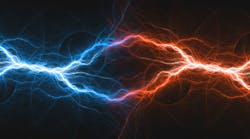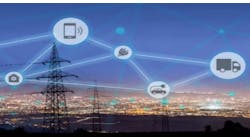We are moving toward an electric future...”the electrification of everything,” as the team at Schneider Electric calls it. So what does that mean for the manufacturing sector amid its digital transformation? We asked Aamir Paul, president of North America operations with Schneider Electric. Take a look…
Smart Industry: What do you mean by the term "the electrification of everything"?
Aamir: Our relationship with energy is changing, both on the industrial side and on the personal/residential side. We are looking to electricity as a cleaner, more efficient, and more resilient way to power our lives. This energy transition began years ago and continues to gain momentum, with federal and local regulations encouraging the purchase of electric vehicles, heat pumps, and other devices over models that traditionally use less efficient resources.
Similar to how the internet revolutionized how we live, we need to prepare for a revolution in how we manage energy over the next 20 years—everything connected, everything electric, and every customer empowered to maximize that energy. New technologies are available to make that happen, ensuring digitalization and security at the local level, as well as a more intelligent grid to make that level of electrification a reality.
The challenge will be around the investment needed for these new technologies and the regulatory approvals necessary to see them come to fruition. Energy regulation was historically structured on a system of yesterday and not policies focused on tomorrow.
I am optimistic, of course, as we have seen very positive steps taken in the Inflation Reduction Act and in the recently announced Department of Energy’s $6B grant to support emissions-reduction projects for heavy industry.
Smart Industry: How does this new electric future align with the digital transformation of industry?
Aamir: With the technology available, it’s possible for every company to be more resilient. The first step is to empower each company to be more responsible in how they use energy. Many are starting at the process level, but others are expanding to the building or company level in their digital transformation.
As we focus on transforming the industrial space, this push to electrify everything brings digitalization to operations that offer new levels of insight into machine or system performance. This new data can optimize that equipment, driving greater efficiency. System-digitalization benefits the company by using more reliable and less expensive electricity to reduce costs, and also provides data-driven adjustments for increased operational efficiency, reducing costs even further. It’s clear: digital makes the invisible visible.
Expanding a bit wider, we know that only 40% of buildings are smart buildings. Companies already digitizing their processes can look to their buildings to identify efficiency using digital controls and building-management systems.
Other companies are taking their digital transformation further, looking to alternative energy sources for savings. In the US, large companies are owning their energy resiliency and security, leveraging renewables with a grid backup. The result: the US has the largest number of microgrid projects in the world. With digital tools managing this local generation, companies are finding greater efficiency and reduced cost by relying less on their local utilities.
Smart Industry: Why is this a critical moment in terms of our electrical infrastructure? What about this approach enables a more intelligent grid?
Aamir: We have seen the fragility of the nationwide grid and the impacts it has on people and businesses, recently with fires in California, freezing temperatures in Texas, and hurricanes on the east coast. 20th century grids won’t deliver 21st century decarbonization goals.
Today, electricity makes up only 20% of the energy we consume. In the next 20 years, that number will jump to between 40-60%. We realize this is a critical moment for action, as a large section of the electrical infrastructure will be built over the next 20 years. We have a remarkable opportunity to rethink our execution to meet this challenge.
Smart Industry: How does the demand side dictate this transition?
Aamir: The energy transition has been discussed by many, but too often the topic is approached from the supply perspective. It’s time to rebalance the debate, as the transition is driven by demand, and more specifically, waste. Reducing waste is the most effective driver of efficiency. As we often say, electricity you don’t waste is electricity you don’t need to generate or transmit.
Let’s consider industrial customers who contend with power quality and consistency challenges that could impact their production and the equipment lifespan. As these customers look to digitize their operations, they will need both more consistent electricity and greater amounts of it. This is similar to what we see in the residential sector. People are spending more time at home and switching to electrical appliances, resulting in a need for more resilient power.
These demands from very different customer groups all fall to the utility, requiring fundamental changes in their business models to meet these challenges.
Smart Industry: How does education come into play here?
Aamir: We all agree that new strategies and technologies are needed to meet the growing electrical demand, but this, too, presents another bottleneck. The solutions that we recommend are newer technologies, and we don’t currently have enough trained professionals at scale to deploy and maintain them.
We’ll need to upskill those currently in the workforce and recruit a new generation of professionals to sustain this future. Smart buildings represent 40% of buildings, so we’ll need teams of professionals with the skills to bring that to 100%. We’ll also need similarly trained professionals to move the needle of smart homes from 15-100%. These jobs will entail energy and automation on local and global scales.
Schneider Electric is already working to address this gap by training one-million people globally through programs and partnerships. Until these skilled professionals are available, this area will be one of the biggest challenges to the energy transition.
Smart Industry: What most encourages you about an electrified future for industry?
Aamir: Electrification and digitalization are keys to driving sustainability. We recognize the challenges ahead of us to make the electrification of everything a reality, but the return is a profitable one to strive for. And, by investing now in technology, infrastructure, and our workforce, we’ll work toward the sustainability goals needed to benefit the planet.


